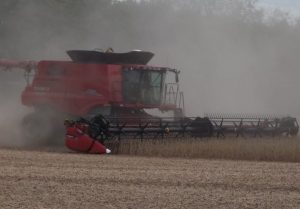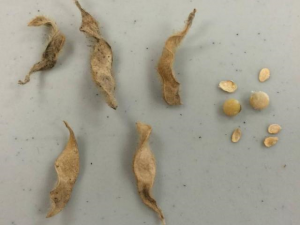Agronomy, Homepage Slider, Soybean Quality
Tips for Harvest and Planning for 2021
By Dr. Anne Dorrance, OSU Extension Plant Pathology, Adapted from C.O.R.N. 2018-33
The 2020 Soybean harvest has started in Ohio. The following items are things to keep track of as the combines run across the fields to help evaluate the 2020 crop and plan for 2021.
- Make note of those low yield spots in soybeans to soil sample for soybean cyst nematode levels.
- Did you leave unsprayed strips? Harvest each of these first separately. Yield is not even throughout a field so comparisons to the average of these unsprayed strips are a more accurate measure of what the baseline level of yield is within a field. This is the number to compare yields for any treatments.
- Note: the outside borders of the field are usually not comparable since these have additional secondary factors such as shade from trees, compaction, old fence rows etc. which can impact yield.
- Fields with Sclerotinia should be harvested last. Yes, seed quality will continue to decline but this will avoid contaminating equipment with sclerotia which can then be introduced into more fields. There are limited fields with this pathogen, and this approach will help keep it that way.
- Fields with stink bug injury, generally moldy due to Phomopsis etc.: harvest those ASAP and get the seed dried down.

SOYBEAN STINKBUG DAMAGE Phomopsis will continue to colonize pods from openings on those pods caused by insect feeding and then colonize the neighboring seeds. This fungus that causes Phomopsis seed decay as well as other seed decay fungi tend to be a bit slow growing. If the seed can be harvested, and dried down it will prevent further growth. It has also been noted that on a seed germination test in the fall, germs will be lower, but the seed where only the outside is colonized, not the germ, the fungus will die under out winter conditions (if the storage is dry) and then the germ will improve over the winter for Phomopsis seed decay.
- While you are also harvesting make note of the varieties that did well on your farms. Not every soybean variety is meant for our wet poorly drained soils. Every year there are reports and observed shallow root systems, extensive root rot, as well as Phytophthora stem rot and sudden death syndrome. In fields where diseases developed, pay attention to the resistance on these and other diseases for 2021.
- Remember, every company uses a different rating system, read the fine print to be sure that you understand what resistance actually means for those varieties. Is 1 dead or is it the best?